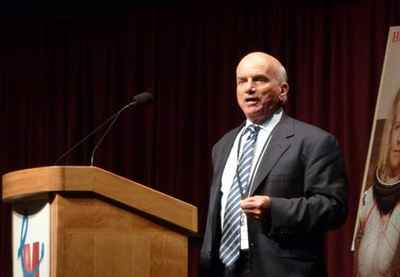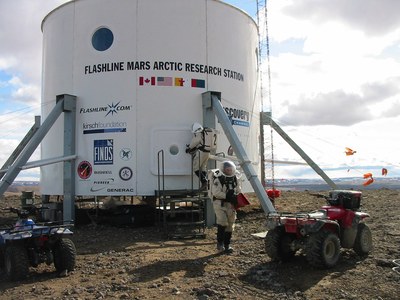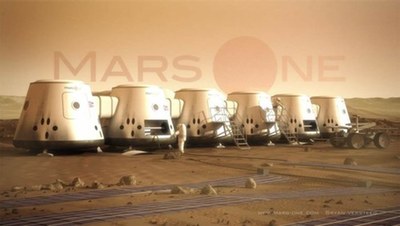The private road to Marsby Jeff Foust
|
| “The paper was very well received, and it was the beginning of giving us some credibility,” Tito said. “But we have a lot of work to do from an engineering standpoint to make sure all of these issues close.” |
That extreme level of difficulty, and corresponding implied extreme expense, has led to the conclusion that only a government, or a coalition of governments, can send humans to Mars. It’s also been a long-term goal: President George W. Bush’s 2004 Vision for Space Exploration featured human missions to Mars at an unspecified date after a 2020 return to the Moon, while President Barack Obama in 2010 called for a human mission to orbit Mars in the mid-2030s and a landing to follow presumably shortly thereafter.
Yet, recently private ventures believe they can beat NASA and other government agencies in this hardest and costliest of human spaceflight ventures. Inspiration Mars is proceeding with plans to mount a 2018 crewed flyby mission, while MarsOne has plans to land humans on Mars—to stay—as early as 2023. What do they know that the experts in the space agencies don’t?
 Dennis Tito, speaking at the Humans to Mars Summit earlier this month, says Inspiration Mars is working to address both technical and financial issues for its proposed 2018 flyby mission. (credit: J. Foust) |
Inspiration Mars: building credibility
The private venture that has captured the most interest in recent months has been Inspiration Mars. Backed by multimillionaire Dennis Tito, the first space tourist to visit the International Space Station back in 2001, Inspiration Mars rolled out plans in February to send a man and a woman—a married couple, most likely—on a 501-day mission to swing by Mars and return to Earth. Making this mission even harder was the timing: the preferred trajectory required a launch in January 2018, less than five years away (see “A Martian adventure for inspiration, not commercialization”, The Space Review, March 4, 2013).
More than two months after unveiling those plans, tied to a paper Tito presented at an aerospace conference in early March, he and others involved with Inspiration Mars show no signs of wavering. “The paper was very well received, and it was the beginning of giving us some credibility,” Tito said in a panel session about Inspiration Mars at the Humans to Mars Summit in Washington on May 8. “But we have a lot of work to do from an engineering standpoint to make sure all of these issues close.”
Those issues include how to launch that crewed spacecraft. One option, said John Carrico of Applied Defense Solutions, part of the Inspiration Mars team, is to use a SpaceX Falcon Heavy launch vehicle, as proposed in that conference paper. The data in the paper was based on publicly available information on the SpaceX website; since the paper’s publication, he said, they talked with some people there and confirmed the data.
Another option, he said, is to use two launches of an Atlas V 552, an as-yet-unflown variant of rocket that uses a dual-engine Centaur upper stage. One launch would place propellant needed for the trans-Mars injection maneuver into low Earth orbit, while the second would carry the spacecraft and crew, who would the rendezvous with the propellant and transfer it to the spacecraft.
Carrico confirmed some rumors that Inspiration Mars is looking at use of NASA’s Space Launch System (SLS) heavy-lift rocket. “Their first launch is planned right now for December 2017, so they would actually be just right on time for us,” he said. Like the Falcon Heavy, SLS could carry out the Inspiration Mars mission with a single launch, and with performance to spare. That additional capability, he said, could be used to refine the trajectory to reduce the reentry velocity when the spacecraft returns to Earth.
| “We cannot guarantee there will be humans on Mars in 2023,” Lansdorp said. |
That reentry is another major technical challenge for Inspiration Mars: the spacecraft would reenter Earth’s atmosphere at a peak velocity of 14.2 kilometers per second, significantly faster than reentries from Earth orbit or even the Moon. Carrico said Inspiration Mars has been working with NASA’s Ames Research Center under a Space Act Agreement to study reentry issues and the required technologies. Analysis performed since the paper’s publication showed that peak heating isn’t as high as previously thought, which could allow the use of “densified” versions of existing heat shield materials. In addition, instead of doing a direct reentry, he said they’re looking at aerocapture approaches to bleed off some velocity in an initial pass through the upper atmosphere.
Another area of study is the health of the crew. “Obviously, the radiation environment is something that we’re concerned about,” said Taber MacCallum of Paragon Space Development Corporation, another member of the Inspiration Mars team. “The consensus is that the risk is manageable.” In an earlier panel at the conference, MacCallum said they estimated a 3–6% increased risk of death from cancer contracted from the radiation exposure accumulated during the mission.
Tito is bankrolling these studies through the end of next year while he works to figure out how to raise the funding—perhaps on the order of $1 billion, although the project hasn’t disclosed specific cost estimates—needed to carry out the mission. “My children are being very generous with their inheritance,” he joked. He reiterated that Inspiration Mars is a philanthropic, not a commercial, venture, and that the Inspiration Mars Foundation is registered with the IRS as a nonprofit organization to accept donations. “We want to open the awareness of this mission to millions of people and get them to participate at relatively modest levels,” he said.
 Bas Lansdorp believes a low-cost mission approach, about which his group has released few details, along with the sale of media rights, makes a private mission to land humans on Mars feasible. (credit: J. Foust) |
Mars One: “the most exciting moment in the history of humankind”
A separate private endeavor, meanwhile, has goals that make Inspiration Mars’s technical and financial challenges look insignificant in comparison. Mars One actually predates Inspiration Mars, with its initial announcement nearly one year ago, but has gained attention in the last few months. The organization, also a nonprofit, seeks to send humans to land on Mars—as permanent settlers—as early as 2023, funded primarily by selling the media rights to those missions.
What has helped trigger this surge in interest in Mars One has been its public call for astronaut candidates. At a media event in New York last month, Mars One officially opened its application process to effectively any adult with access to the Internet. “Round One is where we open the doors to Mars for everyone on Earth,” said Bas Lansdorp, president of Mars One. “This is an international mission and it is very important for the project that anyone anywhere can ask themselves: ‘Do I want this? Am I ready for this?’ If the answer is yes, then we want to hear from you.”
In this initial round, applicants pay a registration fee pegged to their nation’s GDP (between $5 and $73; $38 for those in the US), fill out an application form, and provide a brief video explaining their interest in a one-way Mars mission. After a couple rounds of screening by Mars One committees, the selection process will take on a reality television flavor, with national competitions “which could be broadcasted on TV and internet,” according to Mars One, followed by a final international round, including placing teams in simulated habitats on Earth. This concludes with the selection six teams of four people (two men and two women, representing four different continents) from which the initial group would be picked.
Earlier this month, in a release coinciding with the Humans to Mars Summit, Mars One reported that they had already received 78,000 applications, including more than 17,000 from the US and 10,000 from China. “With seventy-eight thousand applications in two weeks, this is turning out to be the most desired job in history,” Lansdorp said in a release. “These numbers put us right on track for our goal of half a million applicants.”
That 78,000 figure, though, requires a caveat. In an interview during the Humans to Mars Summit, Lansdorp said that figure did not mean all the applicants had completed every stage of the application process. “People register, they pay, they start filling out their information, they have the movie to make, the movie to upload,” he said. That 78,000 figure represents “people who have at least done the first step,” which is to fill out a short form that asks only for an email address, password, date of birth, and country of residence.
Lansdorp did not disclose how many had completed the application process, but on the Mars One site, which displays the videos of people who have applied, less than 800 such videos are listed as of the publication of this article. (There may be additional applicants who elect not to have their videos made public, although that would be an odd choice for a process that has such a public application and, later, selection process.) Lansdorp said last week after a talk at the Space Tech Expo in Long Beach, California, that Mars One wouldn’t release updated application numbers until they hit a “nice round number.”
| “I think it’s a good PR program, probably a good fundraising program, but I don’t think there’s much technical basis behind it,” Aldrin said of Mars One. |
Mars One has attracted scrutiny because of its technical and financial approach. The organization claims that it can place that initial group of four settlers on Mars within a decade for $6 billion. By comparison, another commercial human spaceflight venture, Golden Spike, estimates the cost of developing systems for sending two-person missions to the Moon for brief, Apollo-like stays at just over $7 billion.
Lansdorp has declined to itemize that mission cost for competitive reasons: if they quote a price for a particular component from one supplier, he said in an interview, they’re unlikely to get a much lower price from a competing supplier. “For that reason, we cannot give the cost breakdown of each individual component,” he said. The $6 billion figure has been vetted by an independent group, he said, and includes a “large margin.”
That cost includes precursor robotic missions that will launch starting in 2016. However, Mars One has not let any contracts for those precursor missions (it does have one contract with Paragon to work on life support technology), which suggests to many that they will be unable to stay on schedule given the usual timelines for developing missions. Lansdorp said they’re talking with SpaceX about launching the 2016 mission, as well as trying to acquire duplicates of previous Mars missions. Those schedules, including that of landing people on Mars in 2023, could slip, he admitted. “We cannot guarantee there will be humans on Mars in 2023.”
Mars One seeks to fund that mission largely through the sale of media rights. “This will be the most exciting moment in the history of humankind, more exciting, I think, than the Apollo moment,” he said in his Space Tech Expo talk. “There will be more people watching than during the Olympic Games.” The latest Olympics, in London last year, generated more than $4 billion in revenue, he said.
The Olympics, or other sporting events like the World Cup and Super Bowl that have multibillion-dollar media rights, provide plenty of drama and competition in a concentrated period of a few weeks or even one night. A human mission to Mars won’t provide the same level of drama during the mission, save for the landing and other milestone events. Moreover, the Apollo legacy suggests that public interest would drop off rapidly after the initial landing, jeopardizing the media rights and thus the revenue needed to maintain a lifeline for those people who are living on Mars.
“The media financing will be used primarily for the first two missions,” Lansdorp said in an interview. He said future missions would be supplemented by revenues associated with the intellectual property of the systems used for the missions. He added that his media advisors believe public interest in Mars One missions can be sustained far longer than for Apollo. “We will be sending people that the audience will have selected. They will be their TV friends. It is this human approach that will keep it interesting for a very long time.”
 The Mars Society is raising money to perform a one-year analog Mars mission at its base on Devon Island in the Canadian Arctic. (credit: The Mars Society) |
Humans to Mars in one congressman’s lifetime
Mars One’s ambitious schedule, low estimated costs, and revenue models have generated significant skepticism in the space community. “I think it’s a good PR program, probably a good fundraising program, but I don’t think there’s much technical basis behind it,” said Apollo 11 astronaut Buzz Aldrin, who has been advocating a more conventional, stepping-stone approach to human Mars exploration and settlement, at the Humans to Mars Summit.
“Mars One would be extremely exciting if they could pull it off, but it’s extremely ambitious,” said Robert Zubrin, founder and president of The Mars Society. “The amount of resources required to do it are, so far, not apparent among the group that is pushing it.”
Zubrin, speaking at the National Space Society’s International Space Development Conference (ISDC) in San Diego on May 25, was far more sanguine about Inspiration Mars, calling it “quite a doable thing.” He added that he had proposed a similar Mars flyby mission to Dan Goldin, then the NASA administrator, back in 1995, at a proposed cost of $2 billion. Tito will attend the Mars Society’s annual conference in Colorado in August, Zubrin said, and a half-day workshop there will bring together working groups to study technical and other aspects of the Inspiration Mars mission.
While The Mars Society has no plans to mount a human Mars mission of its own, it plans to help support them with its own terrestrial mission. Last week, the organization said it planned to conduct a year-long mission at its Arctic Mars analog base, the Flashline Mars Arctic Research Station (FMARS), in 2014. FMARS has hosted crews for shorter missions, but none longer than four months in 2007; the last time the station was staffed was in 2009.
At ISDC, Zubrin said the year-long mission would provide a more realistic environment for studying how crews interact than previous simulations, like the Mars500 experiment where six men were confined to a set of modules in a Moscow laboratory. “You’ll deal with the isolation there, and the danger that goes with isolation, not by being in a room in Moscow but by being out there, and simultaneously being tasked to do sustained programs of field exploration,” he said.
| “We think that this mission will put the vision of humans exploring on Mars before the entire world in a way that simply hasn’t been done yet,” Zubrin said. |
The Mars Society has already raised, though cash and in-kind contributions, $80,000 of the $130,000 needed for phase one of the project, which involves an expedition to FMARS this summer to outfit the habitat for the year-long mission. That mission will go forward while the organization raises the remaining $50,000 and also works on funding phase two, the year-long mission. The society estimates that phase to cost $1 million, but Zubrin said after his ISDC presentation that they’re looking at ways to lower that cost, such as having the organizations who provide the crewmembers cover their salaries, that could reduce that total cost by up to half.
“We think that this mission will put the vision of humans exploring on Mars before the entire world in a way that simply hasn’t been done yet,” Zubrin said. “We think this will gather worldwide attention and draw people to the vision of human explorers on Mars.”
Zubrin also believed that, if Inspiration Mars was successful in its Mars flyby mission, it could generate further interest in privately-funded Mars missions. “If the Tito group is successful with Inspiration Mars, they would gain a lot of credibility, so much so that they could probably mobilize the much larger amounts of funds and resources needed to fly people actually to Mars. And if we could so that, then we could raise the resources to do one-way missions to Mars.”
Those additional resources could come from people like Elon Musk, who has previously indicated an interest in creating a human settlement on Mars and even retiring there, although he and his company, SpaceX, have revealed few details of such an effort beyond that long-term aspiration.
And while debates in Congress continue on the best way for NASA to send humans to Mars, one member thinks the private sector has a better chance of getting there. “We will, in my lifetime, if we don’t get in their way and tax all their money and control all of their creative behavior, we will have at least a landing of humankind on Mars, but perhaps even a settlement,” said Rep. Dana Rohrabacher (R-CA) in a speech at the ISDC on May 24.
That statement sounds something like President Obama’s belief that he expected to be around to see a human landing on Mars. However, while Obama will be 52 years old in August, Rohrabacher turns 66 next month. Can private ventures really deliver on such fast-paced schedules, at least when compared to government programs? That remains to be seen, given the significant technical and fiscal obstacles such efforts face. After all, Mars is hard.
